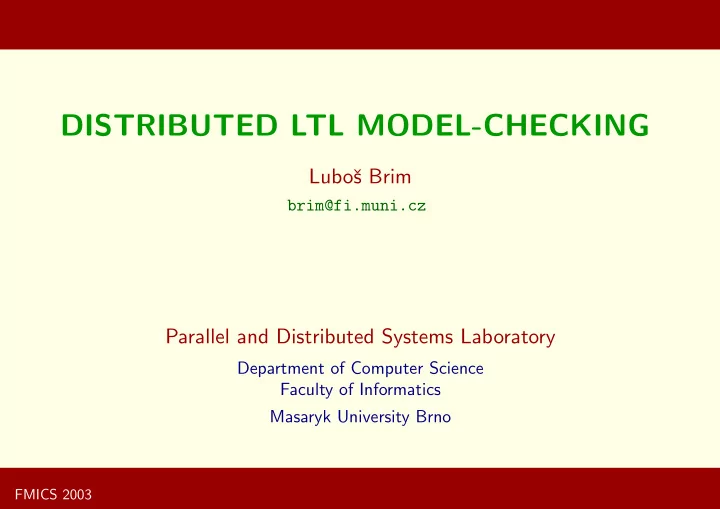

DISTRIBUTED LTL MODEL-CHECKING Luboˇ s Brim brim@fi.muni.cz Parallel and Distributed Systems Laboratory Department of Computer Science Faculty of Informatics Masaryk University Brno FMICS 2003
Overview of the Talk • About CRCIM and ParaDiSe • Distributed LTL Model-Checking • Dependency Structure • Negative Cycles • LTL Properties • Verification Tool • Other Work FMICS 2003 2
ParaDiSe • CRCIM – Czech Research Consortium for Informatics and Mathematics Members: Charles University Prague, Masaryk University Brno Institute of Informatics, Prague Institute of Information Theory and Automation, Prague • Parallel and Distributed Systems Laboratory – ParaDiSe www.fi.muni.cz/paradise • Research in ParaDiSe organized under themes: Algorithms and Tools for Practical Verification of Concurrent Systems FMICS 2003 3
ParaDiSe • Staff – 4 permanent members s Brim, Ivana ˇ Luboˇ Cern´ a, Mojm´ ır Kˇ ret´ ınsk´ y, Anton´ ın Kuˇ cera – 9 PhD students – 12–15 undergraduate students • Funding Faculty of Informatics, Government grant, Grant Agency grants no industrial support FMICS 2003 4
Explicit-State LTL Model-Checking • Emptiness problem for B¨ uchi automata • Searching for accepting cycles in the graph • Nested DFS – linear algorithm • Cycles are recognized using DFS postorder • Postorder problem is P-complete • LTL Model-Checking is not in NC ⇒ difficult to parallelize in theory • Is it possible to solve the problem on real-life cases ? It seems that YES !! FMICS 2003 5
Distributed LTL Model-Checking • Cluster of Workstations (no shared memory) • On-the-Fly • Explicit-state (enumerative) How to Detect Cycles in Parallel • Easy for cycles placed on one workstation • More difficult for cycles splitted among workstations FMICS 2003 6
Distributed LTL Model-Checking Three approaches to detecting cycles: • Ensure the postorder • Do not use DFS • Employ particular knowledge about the problem FMICS 2003 7
Maintaining the DFS Postorder • Second DFS must be started from the accepting states in the postorder defined by the primary DFS • The order of accepting states is important • Special data structure (dependency structure) is used to maintain the proper order of accepting states FMICS 2003 8
Maintaining the DFS Postorder • Dependency structure: – Each workstation maintains its own local dependency structure – Dynamic – vertices are added and removed – Border states and accepting states – Edges represent reachability among these states • Additional memory required: ( O ( n.r ) on average, where r is the maximal out-degree and n is the number of states) • Nested procedures are not performed in parallel FMICS 2003 9
Negative Cycles • Reduce BA emptiness problem to another one which can be distributed more easily • Detecting of negative cycles in the SSSP problem • Given a triple ( G, s, l ) , where G = ( V, E ) is a directed graph with n vertices and m edges, l : E → R is a length function, and s ∈ V is the source vertex. • If there is a negative cycle reachable from s , the graph is not feasible Negative cycle problem is to decide whether G is feasible. FMICS 2003 10
Negative Cycles • Negative cycle problem and B¨ uchi automaton emptiness problem: A B¨ uchi automaton corresponds to a directed graph G A . Let G A = ( G A , s, l ) , where l : E A → { 0 , − 1 } is the length function such that l ( u, v ) = − 1 iff u is an accepting state. • Various strategies: walk to root cycle detection strategy • O ( m.n p ) , where p is the number of processors • from O ( m + n ) to O ( mn ) FMICS 2003 11
Property Driven Distribution • uses the verified property to partition the state space – eliminate division of accepting cycles. • B¨ uchi automaton which is obtained as a synchronous product of two automata. • each state has two parts: the one given by the modeled system and the other one given by the negative claim automaton (representing negation of the verified formula). • use the decomposition of the negative claim automaton into maximal SCCs as a heuristic to partition the state space. FMICS 2003 12
Property Driven Distribution • Three types of SCCs in the negative claim automaton: – F – any cycle within the component contains at least one accepting state – P – there is at least one accepting cycle and one non-accepting cycle within the component – type N – there is no accepting cycle within the component • N – reachability • F – can be detected sequentially without using the nested search and we place each component on a separate workstation • P – distributed detection FMICS 2003 13
Other Work on Distribution • Distribution of Branching Logics (CTL, CTL*, AFMC) • Distributed Verification Environment – DiVinE • environment for easy implementation of our own distributed verification algorithms on clusters of workstations • experimental evaluation and comparison • Main characteristics: ∗ support for the distributed generation of the state space ∗ dynamic load balancing, re-partitioning ∗ distributed generation of counter-examples ∗ algorithms integration and cooperation FMICS 2003 14
Other Work in ParaDiSe • YAHODA - The Database of Verification Tools – 42 tools – http://yahoda.fi.muni.cz • Verification of IPv6 protocol • Randomization • Theoretical Background – Exact classification of the decidability/complexity boundaries for existing verification techniques – Equivalence-checking and model-checking with various classes of models FMICS 2003 15
Recommend
More recommend